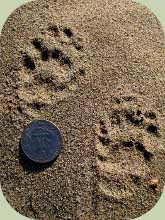Skunk Tracks and Sign:
An Online Field Guide
Skunk tracks can be found in a variety of habitat types including: fields, farmland, deserts, open woodlands, suburbs and parks, usually not far from water.
Skunks are omnivorous eating berries, fruit, eggs, baby birds, small mammals, invertebrates and carrion.
There are 6 species of skunks in North America that range North of the Mexico: the western spotted skunk (Spilogale gracilis), eastern spotted skunk (Spilogale putorius), Hooded skunk (Mephitis macroura), Striped skunk (Mephitis mephitis), western hognose skunk (Conepatus mesoleucus) and eastern hognose skunk (Conepatus leuconotus). Of these, the striped skunks are the most common and well-known.
Tracks:

Like raccoons, bears and opossums, skunks walk with their feet flat to the ground (plantigrade). The feet of skunks have 5 toes on the front and five toes on the back. The tracks of the striped skunk footprints appear like those of a miniature bear. The front feet have long claws that show up as dots well ahead of the toes. The rear feet have an enlarged heel pad that appears long and rectangular in shape in most substrates. The front heel pad is smaller and has a reduced additional pad which may show up as a single dot behind and center of the front heel pad.
Fronts: 1 5/8” – 2 1/16” x 1” – 1 3/16”
Rears: 1 15/16” – 2” x 15/16” – 1 3/16”
Gaits:
Striped skunks can travel in a variety of gaits. They can travel across open expanses in a lope. While moving more slowly to search an area for food they can travel in walk, often an overstep walk.

Scat:
The scat of striped skunks is can vary, but is often tubular, having blunt ends and smooth surface. They are not hard, and break up easily if prodded.
Be More Prepared For Your Next Outdoor Adventure!

Don't leave without knowing these six essential survival skills. Our free survival mini guide reveals the strategies of:
- Shelter & fire to prevent the number one cause of death
- Obtaining clean water to avoid life-threatening dehydration
- Common wild survival foods and other critical skills!

Similar tracks:
The tracks of bears are somewhat similar, but many times larger. The tracks of ground squirrels or large tree squirrels might be confused with skunk tracks. Look closely at the number of toes on both front and hind feet. Like other rodents, squirrels have 4 toes on the front and five on the hind.
References: Elbroch 2003, Halfpenny 1999, Murie 1954, Rezendes 1999.
More Resources on Skunk Tracks:
To find out more about skunks in Washington State check out Washington Department of Fish and Wildlife's Resource Page
Learn about Alderleaf's Wildlife Tracking Courses.
By the way, when you're out tracking or looking for wild animals, it's important to know how to stay safe in the outdoors, especially if you were to get lost. Right now you can get a free copy of our mini survival guide here, where you'll discover six key strategies for outdoor emergencies, plus often-overlooked survival tips.

About the Author: Filip Tkaczyk is a periodic guest teacher at Alderleaf. He also wrote the field guide Tracks & Sign of Reptiles & Amphibians. Learn more about Filip Tkaczyk.
Return from Skunk Tracks back to Wildlife Tracking Articles
Is The Essential Wilderness Survival Skills Course Right for You? Take the "Online Survival Training Readiness" Quiz
See for yourself if this eye-opening course is a good fit for you. It takes just a few minutes! Get your Survival Training Readiness Score Now!

Grow Your Outdoor Skills! Get monthly updates on new wilderness skills, upcoming courses, and special opportunities. Join the free Alderleaf eNews and as a welcome gift you'll get a copy of our Mini Survival Guide.

 The Six Keys to Survival: Get a free copy of our survival mini-guide and monthly tips!
The Six Keys to Survival: Get a free copy of our survival mini-guide and monthly tips!
Learn more